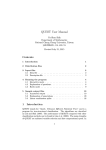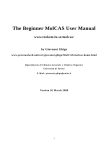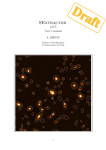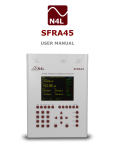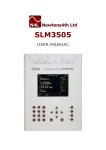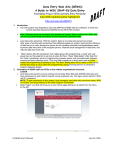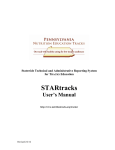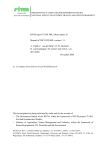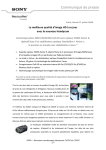Download Details
Transcript
Manual of PEARLNEQ (VERSION COMPATIBLE WITH FOCUS PEARL 3.3.3) Aaldrik Tiktak1, Jos Boesten2 1) MNP, PO BOX 1, 3720 AH BILTHOVEN, the Netherlands 2) Alterra, PO BOX 47, 6700 AA WAGENINGEN, the Netherlands Tip: Start with the default example, provided with the package!!! Release notes: Values in table 6 of the PEARL manual should be replaced by the values in this example (see appendix). The previous version contained a series of small bugs. These bugs have been fixed in this version. The weighing factors for the measurements have changed: all measurements are now given a weighing factor that equals the inverse of each measured value, thus giving equal weight to all measurements. According to recommendations of the FOCUS Kinetics Workgroup, the initial mass in the system should be optimised. This recommendation has been implemented in the current version. A second example (example2.mkn) has been added. This document describes the PEARLNEQ-PEST combination, which can be used to obtain the half-life at reference temperature (DT50Ref), the desorption rate coefficient (CofRatDes), and the multiplication factor for the non-equilibrium sorption coefficient (FacSorNeqEql) in the case of sorption/desorption kinetics. If the incubation experiment has been carried out at multiple temperatures, the molar activation energy (MolEntTra) can be optimised simultaneously. Precautionary remark This PEARLNEQ software tool should be seen as an introduction to fitting results experiments on long-term sorption kinetics to the PEARL sorption submodel. PEARLNEQ shows you how PEST can be coupled to a fortran programme that contains this PEARL sorption submodel (i.e. PEARLNEQ.EXE). PEARLNEQ should not be seen as a ready-to-use tool. PEARLNEQ provides you with example input files to the PEST optimisation package and shows you how to organise this optimisation. We had to make a number of assumptions for generating these PEST input files (e.g. upper and lower bounds of parameters, weighing factors for each measurement, etc. etc.). We do not claim that these assumptions are defensible for your problem; they are our best guesses at this moment. While using PEARLNEQ, we noticed that very regularly the results depend on the initial guesses of the parameters. Therefore we advise you to perform always a 1 number of runs with different initial guesses. We advise you also to analyse the results very carefully (especially the confidence intervals of the estimated parameters). We do not accept any responsibility for use of PEARLNEQ. Running the example The following steps must be followed. 1 Installation. PEARLNEQ is distributed in a self-extracting zip file. Run unpack_pearlneq.exe and specify a path (e.g. c:\pearlneq). The package contains three directories, i.e. Neq_Bin, pest and Neq_Example. The Neq_Bin directory contains the PEARLNEQ executables, PEARLNEQ.EXE and PEARLMK.EXE. The PEST optimisation software is available in the pest directory. As PEST is now available freeware (http://www.sspa.com/pest), we included the latest version as of 29-10-2003 (version 7.0.1.). Separate installation of PEST is not necessary. The Neq_Example directory contains results from an example study, as described in the PEARL user manual, page 51-54. 2 You can now run the example, to check if everything works and get experience with the system. Go to the Neq_Example directory, and run the example, example.bat. The batch file will first call PEARLMK. This pre-processing program generates the input files for PEST, i.e. example.pst, example.tpl and example.ins. Than the optimisation starts. PEST calls PEARLNEQ several times (in the example 39 times). If you get an error message after the first step (PEARLMK), type control-break to stop the process and check the error messages available in the example.err file. 3 After successful optimisation, read the results from the file example.rec. The relevant results, including parameter values, 95% confidence intervals and correlation matrices can be found at the end of this file. PEST also generates parameter sensitivity files etc. Details can be found in the PEST manual, which is available in the PEST subdirectory of the package. 4 If you encounter errors during the second step, you can try running PEARLNEQ directly. PEARLMK has created a file example.neq, which is the input file for PEARLNEQ. Type ..\Neq_Bin\PEARLNEQ EXAMPLE. PEARLNEQ will create an output file (example.out) and a log file (example.log). The output files are self-explaining. 5 You can use the XyWin program to make a graph. XyWin is available in the neq_bin\xypearl directory of PEARLNEQ (the example job does this call for your): ..\Neq_Bin\xypearl\xywin –j example.job –W l 2 Run PEARL_Neq with your own data 1 Be sure that an appropriate incubation experiment has been carried out (see the FOCUS PEARL user manual). The first step of optimising your own data consists of editing the file example.mkn, which can be found in the example subdirectory of the PEARLNEQ directory. Please make a copy of this file before editing. An example of this input file is listed at the end of this appendix. The following parameters must be provided: TimEnd (d): The duration of the incubation experiment. MasSol (g): The mass of dry soil incubated in each jar. VolLiqSol (mL): Volume of liquid in the moist soil during incubation. VolLiqAdd (mL): Volume of liquid added to the soil after incubation (i.e. the amount of liquid added to perform a conventional desorption equilibrium experiment). CntOm (kg.kg-1): Mass fraction of organic matter in the soil. ConLiqRef (mg L-1): Reference concentration in the liquid phase. ExpFre (-): Freundlich exponent. KomEql (L kg-1): coefficient of equilibrium sorption on organic matter. MasIni (µg): The initial total mass of pesticide in each jar. In contrast to the previous version of PEARLNEQ, this parameter will be optimised. There is no default value for this parameter. FacSorNeqEql (-): factor describing the ratio KF,ne/KF,eq. This parameter will be optimised, but you have to specify an initial guess here. The default value is 0.5. CofRatDes (d-1): the desorption rate coefficient. This parameter will be optimised, but you have to specify an initial guess here. The default value is 0.01 d-1. DT50Ref (d): the transformation half-life under reference conditions. applying to the equilibrium domain. This parameter will be optimised, but you have to specify an initial guess here. As a default value, you can use the ‘classical’ half-life, which applies to the total soil system (i.e. the equilibrium domain + the non-equilibrium domain). TemRefTra (C): The reference temperature, at which the half-life should be known. The default values is 20 oC. MolEntTra (kJ mol-1): the molar enthalpy of transformation. This parameter will be optimised if you have carried out the experiment at multiple temperatures; otherwise it is a model-input. If optimised, you have to specify an initial guess here. The default value is 54 kJ mol-1. table Tem (C): List of temperatures at which the incubation experiment has been carried out. At least two temperatures must be specified. table Observations: List of observations. The first column contains the time (d), the second column the temperature, column 3 contains the total mass of pesticide in the system (µg), column 4 contains the concentration of pesticide 3 (µg L-1) in moist soil (then VolLiqAdd = 0) or in the water phase after a desorption experiment (in which case VolLiqAdd is not zero) and column 5 contains the characters ‘OBS’. 2. Repeat step 2-5 in the example. Please replace “example” everywhere it occurs by the name of the copied input file. 3. If the optimization is not succesfull, you can try re-running PEARLNEQ with different initial guesses of MasIni, DT50Ref, FacSorNeqEql and CofRatDes. RunId.mkn PearlMk RunId.ins If Converged RunId.rec RunId.tpl Pest RunId.neq PearlNeq RunId.out Figure 1 Dataflow diagram for the PEARLNEQ-PEST combination 4 RunId.pst Example input file *----------------------------------------------------------------------------------------* STANDARD FILE for PEARLMK version 3.3.3 * Program to fit the half-life, activation energy and desorption rate in the case of * pesticide that show kinetic sorption behaviour * * This file is intended for use with the PEST program (Doherty et al., 1991). * Copyright MNP/RIVM/Alterra 2003, 2005, 2006. * *----------------------------------------------------------------------------------------* Model control Yes ScreenOutput 0.0 TimStart 500.0 TimEnd 0.01 DelTim (d) (d) (d) Start time of experiment Duration of the incubation experiment Time step of output * System characterization 45.36 MasSol 54.64 MasIni 6.64 VolLiqSol 0.0 VolLiqAdd 0.047 CntOm (g) (ug) (mL) (mL) (kg.kg-1) Mass of soil in the icubation jars Initial guess of the initial mass of pesticide Volume of liquid in the moist soil Volume of liquid ADDED for equilibrium experiment Organic matter content * Sorption parameter 1.0 ConLiqRef 0.87 ExpFre 2.1 KomEql 0.5 FacSorNeqEql 0.01 CofRatDes (mg.L-1) (-) (L.kg-1) (-) (d-1) Reference liquid content Freundlich exponent Coefficient of equilibrium sorption on org. matter Initial guess of ratio Kfneq/Kfeql Initial guess of desorption rate coefficient * Transformation parameters 10.00 DT50Ref 20.0 TemRefTra 54.0 MolEntTra (d) (C) (kJ.mol-1) Initial guess of half-life at reference temperature Reference temperature Initial guess of molar activation energy * Temperature at which the incubation experiments are being carried out table Tem (C) 1 5.0 2 15.0 end_table * Measured mass and concentration of pesticide as a function of time and temperature * Tim Tem Mas Con * (d) (C) (ug) (ug/L) table Observations 2 5 51.6300 5.7285 OBS 10 5 50.5900 5.0560 OBS 42 5 46.0200 3.6635 OBS 87 5 38.6100 2.9320 OBS 157 5 32.8150 1.9280 OBS 244 5 25.8700 1.4650 OBS 358 5 20.3150 0.8820 OBS 451 5 9.4250 0.6015 OBS 2 15 51.3300 5.8955 OBS 6 15 47.3950 4.4425 OBS 10 15 45.0650 3.9510 OBS 42 15 23.1400 1.6470 OBS 87 15 10.8950 0.6710 OBS 157 15 3.1350 0.1525 OBS 244 15 1.4400 0.0305 OBS 358 15 0.4500 0.0000 OBS 451 15 0.1500 0.0000 OBS end_table 5 Appendix Results (last section of rec file) These are the results of the default example, provided with the package. OPTIMISATION RESULTS Parameters -----> Parameter fsne crd dt50 masini met Estimated value 0.600286 1.226317E-02 13.0062 56.0664 108.755 95% percent confidence limits lower limit upper limit 0.408681 0.791892 9.886449E-03 1.463989E-02 11.5100 14.5024 52.1243 60.0084 102.806 114.705 Note: confidence limits provide only an indication of parameter uncertainty. They rely on a linearity assumption which may not extend as far in parameter space as the confidence limits themselves - see PEST manual. See file EXAMPLE.SEN for parameter sensitivities. Observations -----> Observation o1 o2 o3 o4 o5 o6 o7 o8 o9 o10 o11 o12 o13 o14 o15 o16 o17 o18 o19 o20 o21 o22 o23 o24 o25 o26 o27 o28 o29 o30 o31 o32 o33 o34 Measured value 51.6300 5.72850 50.5900 5.05600 46.0200 3.66350 38.6100 2.93200 32.8150 1.92800 25.8700 1.46500 20.3150 0.882000 9.42500 0.601500 51.3300 5.89550 47.3950 4.44250 45.0650 3.95100 23.1400 1.64700 10.8950 0.671000 3.13500 0.152500 1.44000 3.050000E-02 0.450000 0.00000 0.150000 0.00000 Calculated value 55.5316 5.39742 53.4684 5.08081 46.2635 4.06320 38.2669 3.09390 29.0458 2.16483 20.9646 1.47675 13.8380 0.932184 9.90684 0.648450 53.3843 5.17830 48.4369 4.62304 43.9959 4.12910 21.3140 1.70735 8.98367 0.544736 3.26320 0.131795 1.24259 3.866613E-02 0.399623 1.077987E-02 0.162574 4.019330E-03 Residual -3.90156 0.331082 -2.87844 -2.480823E-02 -0.243511 -0.399703 0.343149 -0.161897 3.76922 -0.236828 4.90536 -1.175005E-02 6.47702 -5.018437E-02 -0.481840 -4.694962E-02 -2.05426 0.717199 -1.04190 -0.180537 1.06909 -0.178099 1.82600 -6.034768E-02 1.91133 0.126264 -0.128203 2.070505E-02 0.197406 -8.166130E-03 5.037676E-02 -1.077987E-02 -1.257429E-02 -4.019330E-03 Weight 1.9000E-02 0.1750 2.0000E-02 0.1980 2.2000E-02 0.2730 2.6000E-02 0.3410 3.0000E-02 0.5190 3.9000E-02 0.6830 4.9000E-02 1.134 0.1060 1.663 1.9000E-02 0.1700 2.1000E-02 0.2250 2.2000E-02 0.2530 4.3000E-02 0.6070 9.2000E-02 1.490 0.3190 6.557 0.6940 32.79 2.222 1.000 6.667 1.000 See file EXAMPLE.RES for more details of residuals in graph-ready format. 6 Group no_name no_name no_name no_name no_name no_name no_name no_name no_name no_name no_name no_name no_name no_name no_name no_name no_name no_name no_name no_name no_name no_name no_name no_name no_name no_name no_name no_name no_name no_name no_name no_name no_name no_name See file EXAMPLE.SEO for composite observation sensitivities. Objective function -----> Sum of squared weighted residuals (ie phi) = 0.4297 = 0.8997 Correlation Coefficient -----> Correlation coefficient Analysis of residuals -----> All residuals:Number of residuals with non-zero weight Mean value of non-zero weighted residuals Maximum weighted residual [observation "o13"] Minimum weighted residual [observation "o30"] Standard variance of weighted residuals Standard error of weighted residuals = 34 = 1.3161E-02 = 0.3174 = -0.2677 = 1.4816E-02 = 0.1217 Note: the above variance was obtained by dividing the objective function by the number of system degrees of freedom (ie. number of observations with non-zero weight plus number of prior information articles with non-zero weight minus the number of adjustable parameters.) If the degrees of freedom is negative the divisor becomes the number of observations with non-zero weight plus the number of prior information items with non-zero weight. Parameter covariance matrix -----> fsne crd dt50 masini met fsne 8.7787E-03 8.4444E-05 -5.6502E-02 6.4073E-02 0.1016 crd 8.4444E-05 1.3507E-06 -4.5078E-04 6.0200E-04 6.0023E-04 dt50 -5.6502E-02 -4.5078E-04 0.5353 -0.5756 -1.463 masini 6.4073E-02 6.0200E-04 -0.5756 3.716 -0.8663 met 0.1016 6.0023E-04 -1.463 -0.8663 8.463 masini 0.3548 0.2687 -0.4081 1.000 -0.1545 met 0.3727 0.1775 -0.6872 -0.1545 1.000 Parameter correlation coefficient matrix -----> fsne crd dt50 masini met fsne 1.000 0.7755 -0.8242 0.3548 0.3727 crd 0.7755 1.000 -0.5301 0.2687 0.1775 dt50 -0.8242 -0.5301 1.000 -0.4081 -0.6872 Normalized eigenvectors of parameter covariance matrix -----> fsne crd dt50 masini met Vector_1 1.4335E-02 -0.9999 9.4905E-04 7.8350E-05 7.0894E-05 Vector_2 -0.9842 -1.4279E-02 -0.1745 -1.4702E-02 -1.9859E-02 Vector_3 0.1744 1.5744E-03 -0.9453 -0.2006 -0.1889 Vector_4 -2.2879E-02 -1.9999E-04 0.2229 -0.9685 -0.1084 Vector_5 1.1198E-02 6.4642E-05 -0.1618 -0.1467 0.9758 Eigenvalues -----> 4.7821E-07 1.7663E-03 0.1313 7 3.753 8.837







